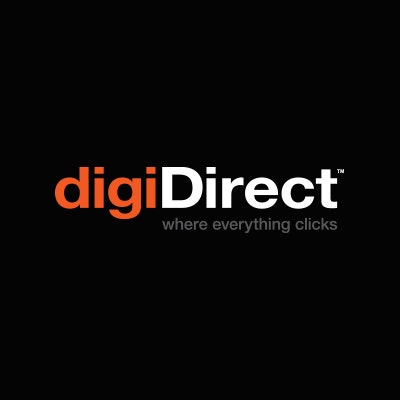
Written by digiDirect
If you're eyeing off a new camera as a beginner photographer, it's hard to avoid the discussion around DLSR vs Mirrorless. Trying to decipher the differences can be a bit intimidating, and if you're confused about the choice, we're here to help. digiDirect has put together this short guide to the technical and functional differences between mirrorless and DSLR cameras, helping you make the smarter choice for your next purchase. Read on so you can know before you buy.
Understanding the Difference
Fundamentally, the difference between a DSLR (digital single-lens reflex) camera and a mirrorless camera is how the image is transmitted to the viewfinder before it reaches the sensor. In a DSLR, light enters through the lens and is reflected upward by what is called a reflex mirror ' a piece of reflective material that sits at a 45-degree angle. The sensor, which is what actually captures the photograph, is behind this mirror, so the light is not actually hitting the sensor at this point. The reflex mirror reflects the light upwards, where it hits the pentaprism which reflects the light again into the viewfinder, which is how you can see what the lens 'sees'. This is why the viewfinder on a DSLR is called an optical viewfinder, as the light coming into the lens is optically reflected directly into the viewfinder. When it's time to take a photo, the shutter release causes the reflex mirror to flip up. This exposes the sensor, which is what records the image detail as a photograph. However, since the mirror is flipped up, this disrupts the light's path to the viewfinder, which is why the viewfinder in a DSLR flashes black as you take a photo.
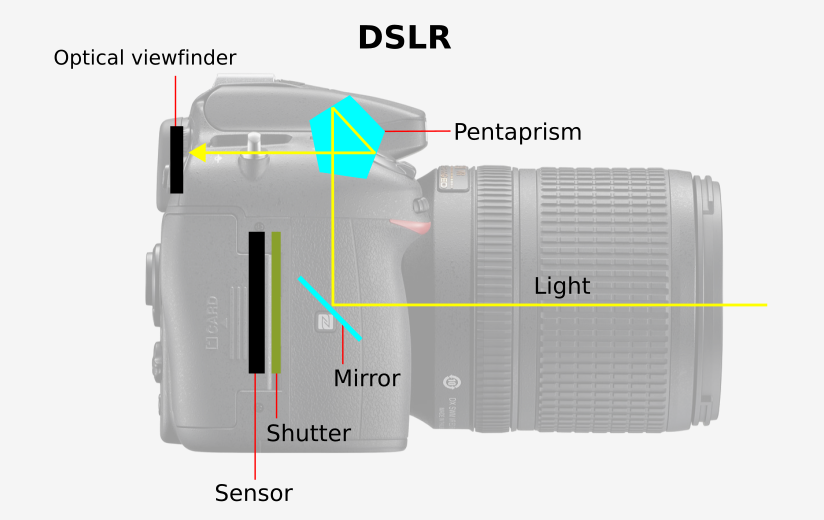
On a DSLR, light is bounced by the mirror into the pentaprism, where it is reflected into the viewfinder. When a photo is taken, the mirror flips up. This interrupts the flow, allowing the the light hit the sensor, but causing the viewfinder goes dark
A mirrorless camera dispenses with the whole reflex mirror and pentaprism system (hence the name). Instead, the light passing through the lens always is projected straight onto the image sensor, with no mirror or other obstacle in between. As a result, there is no way to have the viewfinder be a true optical display, as the viewfinder is not receiving reflected light from the lens. Instead, inside the viewfinder of a mirrorless camera is simply a small, high resolution screen which displays in real time the information that the sensor is capturing. In practice, it's essentially just a smaller and higher resolution version of the screen on the back of the camera. In this way it simulates what you would see if you had an optical viewfinder.
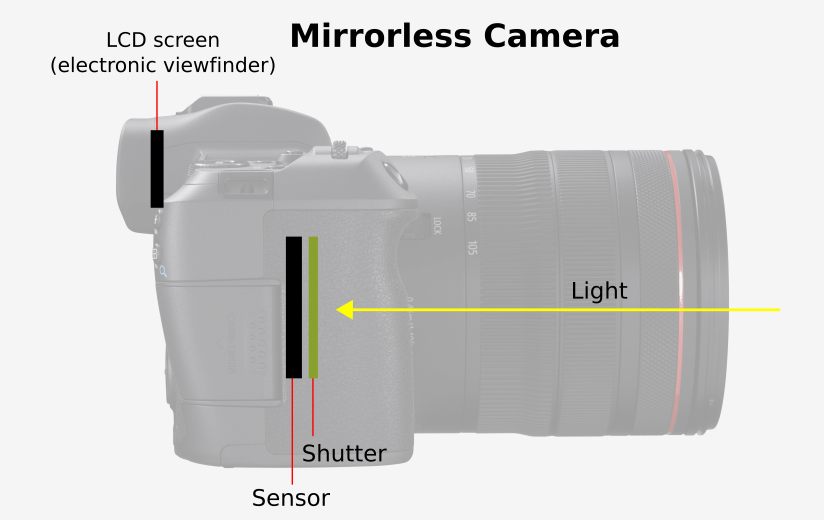
On a mirrorless camera, the light goes directly into the sensor and the viewfinder is an electronic screen
What This Means for Photographers
Size
The first thing you'll notice when holding a DSLR in one hand and a mirrorless camera in the other is the difference in body size. The lack of a mirror and pentaprism in mirrorless cameras means that camera manufacturers can cut a significant amount of size and weight off the body. For comparison, Canon's entry-level EOS 800D DSLR camera weighs in at 485 grams, while their beginner-friendly EOS M50 mirrorless camera is nearly 20% lighter at 387 grams. This might not sound like much, but if you're hauling a camera around all day on an extended shoot, you'll feel that extra 98 grams. This is not always the case, larger mirrorless cameras do exist, but typically they are smaller and lighter than their DSLR counterparts.
Viewfinder
As already discussed, another major difference is the optical viewfinder on a DSLR vs the electronic viewfinder on a mirrorless camera. Back when mirrorless cameras were new, this was a big advantage in the DSLR's favour. Electronic viewfinders were lower in quality and the optical viewfinder of a DSLR was decidedly superior. However, at this point this has changed significantly. Electronic viewfinders have improved by leaps and bounds, and their quality level on average now meets or (some would argue) even exceeds that of optical viewfinders, while also allowing a variety of features that DSLRs do not have access to.
A major advantage of electronic viewfinders is that, since they are just a digital screen, there is much more opportunity to overlay more data on that screen. Anything that the LCD screen on the back of the camera can display can be represented in the electronic viewfinder; histograms, focus peaking, focus magnification, etc. You can even scroll through the menus in the viewfinder! Most optical viewfinders have a basic level guide and autofocus point preview overlaid onto the viewfinder, but they can't display the amount of information that an electronic viewfinder can.

Electronic viewfinders can overlay a range of information on top of the image itself
The electronic viewfinder can also display a live preview of what your photos/video will look like once captured based on your current camera settings. For example, if your current settings will underexpose a photo, the electronic viewfinder can show this visually and it will look underexposed in the viewfinder, giving you a direct visual cue to adjust your exposure. Optical viewfinders include a scale that indicates if the photo will be under or overexposed, but the exact exposure that your settings will capture once you press the shutter button won't be reflected in what you actually see through the viewfinder. Similarly, depth of field is not fully represented through an optical viewfinder, where as it can be in an electronic viewfinder. Overall, with an optical viewfinder, if you want to see exactly what the photo ended up looking like, you'll have to check it on the back LCD screen after taking the photo (frequently checking your LCD screen while taking photos is called 'chimping'). Experienced photographers can certainly use the exposure scale present in a DSLR viewfinder to very accurately expose their photos and not have to constantly chimp, but it is a bit less of a direct visual indicator than an electronic viewfinder can provide.
The final advantage of an electronic viewfinder is the lack of disruption when taking photos and video. Because the mirror in a DSLR has to flip up to expose the sensor, anytime that you actually take a photo or video the viewfinder will black out because the mirror will flip up. In fact, video requires that the mirror remains up to capture ongoing information, so a DSLR's viewfinder will be completely black during video shooting and you instead have to shoot video using the back LCD screen exclusively. Mirrorless cameras aren't affected by this and many can shoot photos through the viewfinder without interruption and all can shoot video while still fully utilising the viewfinder.
All this being said, many people still prefer the feel of an optical viewfinder, particularly those who have been shooting for some time and therefore have more experience with an optical viewfinder. Electronic viewfinders - particularly lower quality ones - can occasionally struggle in dark or unusual lighting conditions. Also, as the electronic viewfinder is a powered screen, the camera needs to be on in order to use them (optical viewfinders don't have this requirement). It also means that they take up extra power. As a result, DSLRs tend to have slightly longer battery life than mirrorless cameras. Our recommendation would be to try both options in person to see which appeals to you more in practice, as it can be a subjective preference.
Autofocus
Another historical point of difference between mirrorless and DSLR cameras has been autofocus performance. To avoid getting too technical, traditionally DSLRs had faster focusing systems back when mirrorless cameras were newer. However, this benefit has been largely erased over the past few years and now one format is not inherently faster or slower at autofocusing than the other. These days, both DSLR and mirrorless systems can output fantastically fast and accurate autofocus performance. Your autofocus performance will be much more dependant on the exact model of camera you choose, rather than the format of that model.
Image Stabilisation
Image stabilisation is an important feature that reduces the handheld shake inherent when a human holds a camera (as opposed to when the camera is mounted on a tripod). Better image stabilisation allows you to shoot handheld photos more effectively with a lower shutter speed (good for low light shooting) or at longer focal lengths (good for telephoto shooting). For video, it gives the video a smoother, less shaky and more professional look. Many DSLRs have image stabilisation built into their lenses - these systems have been around for some time and they do a good job. However, mirrorless cameras have recently been building their stabilisation system into the camera sensor itself, rather than into their lenses. This means that any lens on the camera will benefit from the stabilisation - not just image stabilised lenses - including vintage or antique lenses. The effectiveness of these systems has also recently started to significantly surpass the effectiveness of the lens stabilisation systems on DLSRs. Note that not all mirrorless cameras have these built-in stabilisation systems, they are of varying quality, and some still utilise lens stabilisation systems as well. However, the highest-performing stabilisation systems are all found on mirrorless cameras.
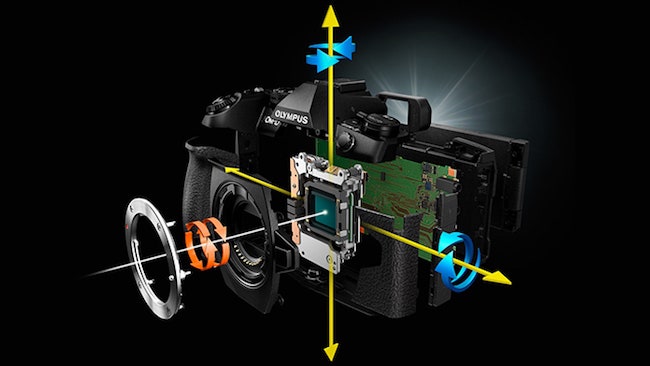
A 5-axis stabilised sensor on a Olympus mirrorless camera. Image courtesy of Olympus
Image Quality
In terms of image quality, there's little difference between DSLRs and mirrorless cameras. The actual sensor inside the cameras - which is responsible for the final picture quality - is very similar between DLSRs and mirrorless cameras. A few different sized sensors are used, with both mirrorless and DLSRs having full frame and APS-C sensor sizes. Panasonic and Olympus also make Micro Four Thirds mirrorless cameras that have a slight smaller sensor size that doesn't have an exact equivalent in a DSLR.
Lens Selection
A final point worth noting is the range of lenses available for each camera body type. In this field, DSLRs are unmatched. Both Canon and Nikon DLSRs have the most extensive lens libraries around, numbering well into the hundreds. This is because their DSLR systems have been around much longer, and they also use the same lens mount that Canon and Nikon's film systems have used for decades. As a result, their lens lineup is the most robust, and you can even use much older film lenses on these cameras. This gives DSLR users unparalleled versatility and customisability ' if they have the money to afford it, of course.
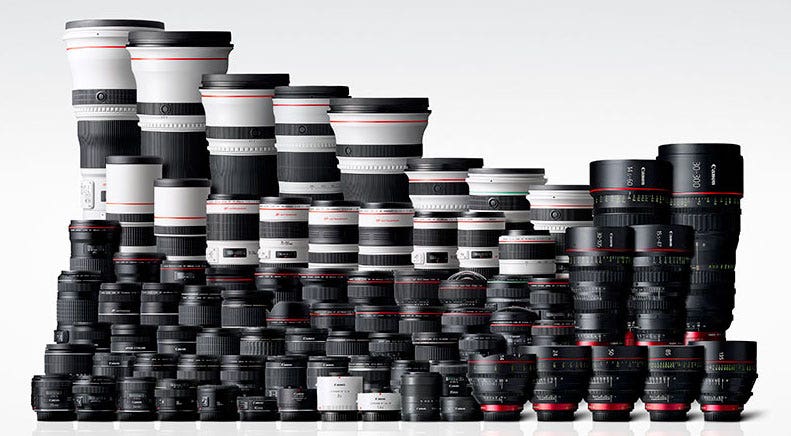
Canon has an extremely large selection of DSLR lenses to choose from - pictured is only a small portion of them. Image courtesy of Canon
While mirrorless cameras don't have nearly as large a selection, they certainly aren't lacking for choice. Sony and Fujifilm have both made large strides in recent years in beefing up their lens catalogue, while Olympus and Panasonic's Micro Four Thirds cameras share the same mount, meaning Olympus lenses can be used on Panasonic Micro Four Thirds bodies, and vice versa. In addition, third-party lens manufacturers like Sigma and Tamron who have traditionally focused on DLSR lenses are now starting to branch out into producing mirrorless lenses. There are some newer mirrorless systems, notably Canon and Nikon's own mirrorless offerings, as well as Panasonic's full frame S mirrorless lineup that as of yet only have a small lens selection, but generally speaking most mirrorless systems have now reached the point of having plenty of choice. DSLRs still currently offer the maximum amount of choice in terms lens selection, however.
Making the Right Decision for You
If you're a beginner photographer looking to get serious about your art, choosing the right camera can be a daunting decision. For those new to photography, Mirrorless vs DSLR can seem like a question with a wrong answer, but advances in technology have narrowed the field and made it an easier decision.
Generally speaking, mirrorless cameras are the direction that the industry is heading, and they offer some critical advantages - small size, technological sophistication, etc - over DSLRs while maintaining high performance and image quality levels. Every single brand makes mirrorless cameras, and in fact Canon and Nikon are the only major brands that are still significantly invested in DSLRs - Fujifilm, Panasonic and Olympus are all exclusively mirrorless, and Sony is heavily focused on mirrorless with only one DSLR model still current.
That being said, Canon and Nikon's dominance in the industry and their long legacy of DSLR production and associated extensive lens catalogue means that DSLRs will still be around for many years to come. Indeed, most professional photographers, particularly those who shoot in demanding areas like sports and wildlife, still primarily use DSLRs as their main camera system. This is slowly changing, but don't expect an overnight switch to mirrorless from most pros!
Overall, both formats have excellent models within their range and there is not a wrong choice. If small size and weight and the benefits of an electronic viewfinder appeal to you, you will most likely want to look at a mirrorless system. If you place more value on an extremely wide lens selection, a legacy of decades of development and refinement and you prefer an optical viewfinder, a DSLR should be your format of choice.
If you're still unsure which camera is right for you, the friendly team at digiDirect are here to help. Start a conversation with our team on 1300 889 148 and let us help you get started.















































































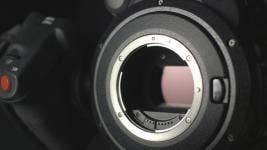

Comments
No Comments yet. Be the first to comment.